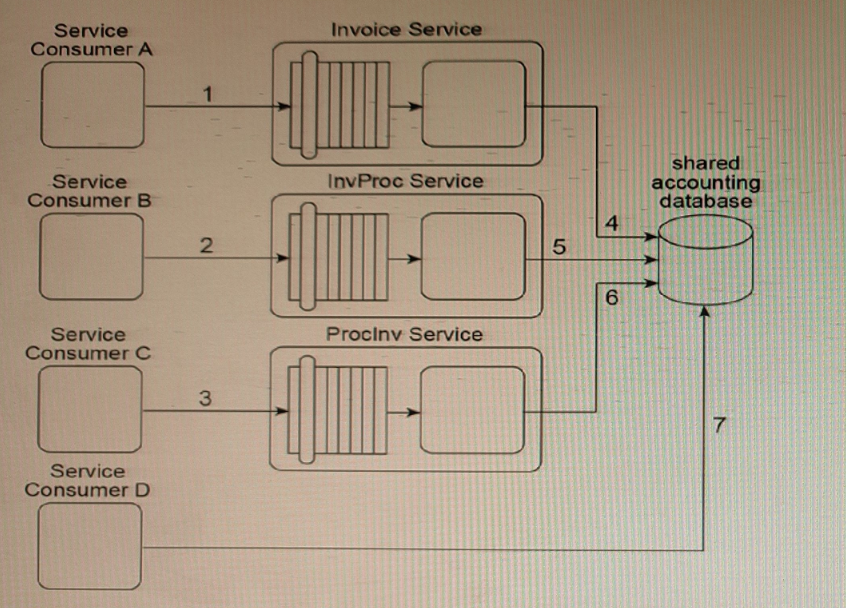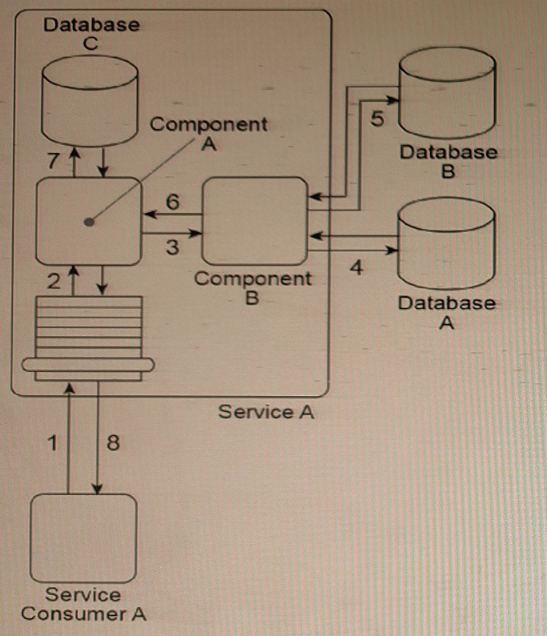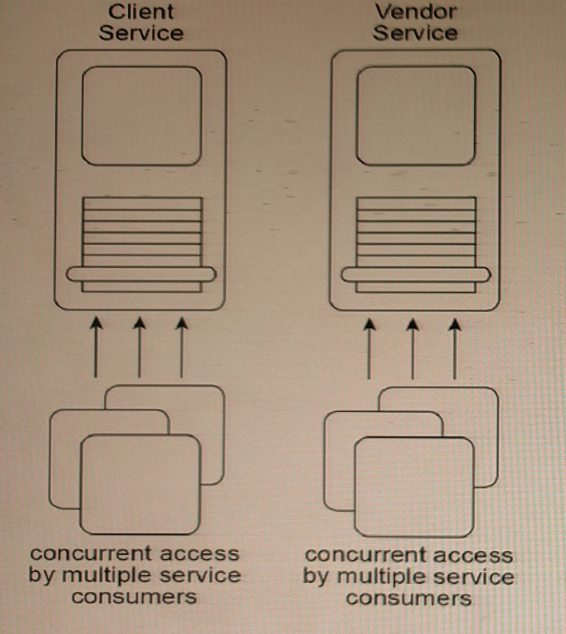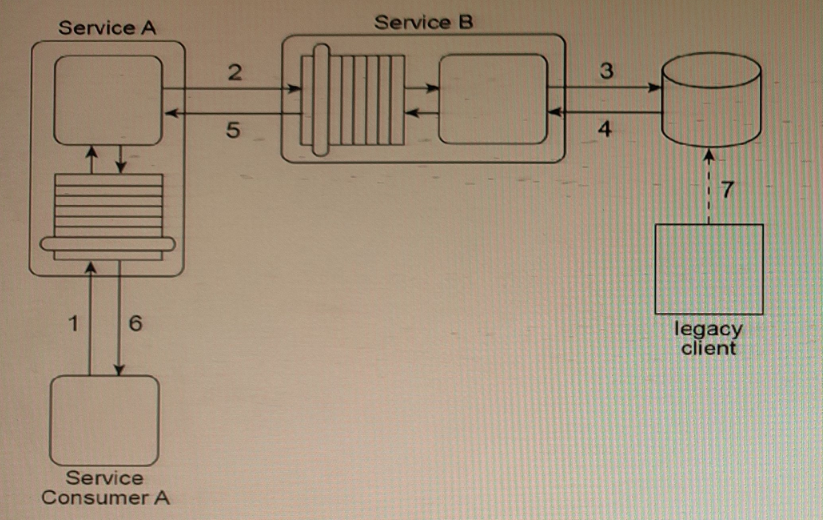Arcitura Education SOA Design & Architecture Lab with Services & Microservices S90.08B Exam Practice Test
Refer to Exhibit.

Service Consumer A sends a message to Service
Answer : B
By separating the individual implementations of Service A onto different physical servers, they can be isolated from each other and from other clients and applications in the IT enterprise, which can help improve performance. Additionally, using the Service Data Replication pattern to give each implementation of Service A its own copy of the data it requires from the shared database can help reduce the load on the shared database and improve performance. This can be especially important when a new service capability is added that requires access to the shared database, as it can help ensure that the performance of Service A is not impacted by the additional demands placed on the shared database.
Refer to Exhibit.

Our service inventory contains the following three services that provide Invoice-related data access capabilities: Invoice, InvProc and Proclnv. These services were created at different times by different project teams and were not required to comply with any design standards. Therefore, each of these services has a different data model for representing invoice data.
Currently, each of these three services has a different service consumer: Service Consumer A accesses the Invoice service (1), Service Consumer B (2) accesses the InvProc service, and Service Consumer C (3) accesses the Proclnv service. Each service consumer invokes a data access capability of an invoice-related service, requiring that service to interact with the shared accounting database that is used by all invoice-related services (4, 5, 6).
Additionally, Service Consumer D was designed to access invoice data from the shared accounting database directly (7). (Within the context of this architecture, Service Consumer D is labeled as a service consumer because it is accessing a resource that is related to the illustrated service architectures.)
Assuming that the Invoice service, InvProc service and Proclnv service are part of the same service inventory, what steps would be required to fully apply the Official Endpoint pattern?
Answer : B
he Legacy Wrapper pattern can be applied so that Component B is separated into a separate utility service that wraps the shared database. The Legacy Wrapper pattern can be applied again so that Component C is separated into a separate utility service that acts as a wrapper for the legacy system API. The Legacy Wrapper pattern can be applied once more to Component D so that it is separated into another utility service that provides standardized access to the file folder. The Service Facade pattern can be applied so that three facade components are added: one between Component A and each of the new wrapper utility services. This way, the facade components can compensate for any change in behavior that may occur as a result of the separation. The Service Composability principle can be further applied to Service A and the three new wrapper utility services so that all four services are optimized for participation in the new service composition. This will help make up for any performance loss that may result from splitting the three components into separate services.
By applying the Legacy Wrapper pattern to separate Components B, C, and D into three different utility services, the shared resources within the IT enterprise (Database A, the legacy system, and the file folders) can be properly encapsulated and managed by dedicated services. The Service Facade pattern can then be used to create a facade component between Component A and each of the new wrapper utility services, allowing them to interact seamlessly without affecting Service Consumer A's behavior.
Finally, the Service Composability principle can be applied to ensure that Service A and the three new wrapper utility services are optimized for participation in the new service composition. This will help to mitigate any performance loss that may result from splitting the three components into separate services.
Refer to Exhibit.

Service A is a utility service that provides generic data access logic to a database containing data that is periodically replicated from a shared database (1). Because the Standardized Service Contract principle was applied to the design of Service A, its service contract has been fully standardized.
The service architecture of Service A Is being accessed by three service consumers. Service Consumer A accesses a component that is part of the Service A Implementation by Invoking it directly (2). Service Consumer B invokes Service A by accessing Its service contract (3). Service Consumer C directly accesses the replicated database that Is part of the Service A Implementation (4).
You've been told that the reason Service Consumers A and C bypass the published Service A service contract is because, for security reasons, they are not allowed to access a subset of the capabilities in the API that comprises the Service A service contract. How can the Service A architecture be changed to enforce these security restrictions while avoiding negative forms of coupling?
Answer : C
The Contract Centralization pattern can be applied to force service consumers to access the Service A architecture via its published service contract only. The Service Loose Coupling principle can then be applied to ensure that the centralized service contract does not contain any content that is dependent on or derived from the underlying service implementation. This will enforce the security restrictions while avoiding negative forms of coupling. By ensuring loose coupling, changes to the implementation of Service A will not require changes to its published service contract, making it easier to maintain and evolve the service.
Refer to Exhibit.

Service Consumer A sends a message to Service A (1), which then forwards the message to Service B (2). Service B forwards the message to Service C (3), which finally forwards the message to Service D (4). However, Services A, B and C each contain logic that reads the contents of the message to determine what intermediate processing to perform and which service to forward the message to. As a result, what is shown in the diagram is only one of several possible runtime scenarios.
Currently, this service composition architecture is performing adequately, despite the number of services that can be involved in the transmission of one message. However, you are told that new logic is being added to Service A that will require it to compose one other service to retrieve new data at runtime that Service A will need access to in order to determine where to forward the message to. The involvement of the additional service will make the service composition too large and slow.
What steps can be taken to improve the service composition architecture while still accommodating the new requirements and avoiding an increase in the amount of service composition members?
Answer : D
This solution addresses the issue of the service composition becoming too large and slow by introducing a new Routing service that is invoked by messages read from a messaging queue. This allows Service A and Service C to determine where to forward messages to at runtime without the need for additional services in the composition. The Service Loose Coupling principle is applied to ensure that the new Routing service remains decoupled from other services so that it can perform its routing functions independently from service contract invocation.
Refer to Exhibit.

Service Consumer A sends Service A a message containing a business document (1). The business document is received by Component A, which keeps the business document in memory and forwards a copy to Component B (3). Component B first writes portions of the business document to Database A (4). Component B then writes the entire business document to Database B and uses some of the data values from the business document as query parameters to retrieve new data from Database B (5).
Next, Component B returns the new date* back to Component A (6), which merges it together with the original business document it has been keeping in memory and then writes the combined data to Database C (7). The Service A service capability invoked by Service Consumer A requires a synchronous request-response data exchange. Therefore, based on the outcome of the last database update, Service A returns a message with a success or failure code back to Service Consumer A (8).
Databases A and B are shared, and Database C is dedicated to the Service A service architecture.
There are several problems with this architecture. The business document that Component A is required to keep in memory (while it waits for Component B to complete its processing) can be very large. The amount of runtime resources Service A uses to keep this data in memory can decrease the overall performance of all service instances, especially when it is concurrently invoked by multiple service consumers. Additionally, Service A can take a long time to respond back to Service Consumer A because Database A is a shared database that sometimes takes a long time to respond to Component B. Currently, Service Consumer A will wait for up to 30 seconds for a response, after which it will assume the request to Service A has failed and any subsequent response messages from Service A will be rejected.
What steps can be taken to solve these problems?
Answer : B
The problems with the current architecture can be addressed by applying the following patterns:
Service Statelessness principle and State Repository pattern - This pattern allows Component A to defer the business document data to a state database while it waits for a response from Component B. This helps reduce the amount of runtime resources Service A uses to keep the data in memory and improves overall performance.
Service Autonomy principle and Service Data Replication pattern - This pattern allows Component B to access a dedicated replicated database instead of the shared Database A, which can improve response time.
Asynchronous Queuing pattern - This pattern allows Service A to use a message queue to communicate with Service Consumer A asynchronously. This means that Service Consumer A does not need to remain stateful while waiting for a response from Service A, which can improve overall performance and scalability.
Therefore, option B is the correct answer. Option A is incorrect because it suggests using the Compensating Service Transaction pattern to raise awareness of the eventual response rejection, which does not actually solve the problem. Option C is also incorrect because it suggests using multiple patterns, which may not be necessary and can add unnecessary complexity to the architecture.
Refer to Exhibit.

The Client and Vendor services are agnostic services that are both currently part of multiple service compositions. As a result, these services are sometimes subjected to concurrent access by multiple service consumers.
The Client service primarily provides data access logic to a client database but also coordinates with other services to determine a clients credit rating. The Vendor service provides some data access logic but can also generate various dynamic reports based on specialized business requirements.
After reviewing historical statistics about the runtime activity of the two services, it is discovered that the Client service is serving an ever-increasing number of service consumers. It is regularly timing out, which in turn increases its call rate as service consumers retry their requests. The Vendor service occasionally has difficulty meeting its service-level agreement (SLA) and when this occurs, penalties are assessed.
Recently, the custodian of the Client service was notified that the Client service will be made available to new service consumers external to its service inventory. The Client service will be providing free credit rating scores to any service consumer that connects to the service via the Internet. The Vendor service will remain internal to the service inventory and will not be exposed to external access.
Which of the following statements describes a solution that addresses these issues and requirements?
Answer : A
This solution addresses the specific requirements and issues identified in the scenario. The Official Endpoint pattern can be applied to the Client service to establish a managed endpoint for consumption by service consumers external to the service inventory, which will allow for controlled and managed access to the service. The Concurrent Contracts pattern can be applied to the Vendor service, which will enable it to connect with alternative Client service implementation if the first attempt to connect fails, thereby increasing its availability and reducing the possibility of penalties being assessed due to not meeting its SLA.
Refer to Exhibit.

Service A is an entity service that provides a Get capability which returns a data value that is frequently changed.
Service Consumer A invokes Service A in order to request this data value (1). For Service A to carry out this request, it must invoke Service B (2), a utility service that interacts (3, 4) with the database in which the data value is stored. Regardless of whether the data value changed, Service B returns the latest value to Service A (5), and Service A returns the latest value to Service Consumer A (6).
The data value is changed when the legacy client program updates the database (7). When this change will occur is not predictable. Note also that Service A and Service B are not always available at the same time.
Any time the data value changes, Service Consumer A needs to receive It as soon as possible. Therefore, Service Consumer A initiates the message exchange shown In the figure several times a day. When it receives the same data value as before, the response from Service A Is ignored. When Service A provides an updated data value, Service Consumer A can process it to carry out its task.
The current service composition architecture is using up too many resources due to the repeated invocation of Service A by Service Consumer A and the resulting message exchanges that occur with each invocation.
What steps can be taken to solve this problem?
Answer : A
This solution is the most appropriate one among the options presented. By using the Event-Driven Messaging pattern, Service A can be notified of changes to the data value without having to be invoked repeatedly by Service Consumer A, which reduces the resources required for message exchange. Asynchronous Queuing ensures that the event notification message is not lost due to the unavailability of Service A or Service B. This approach improves the efficiency of the service composition architecture.